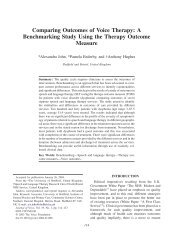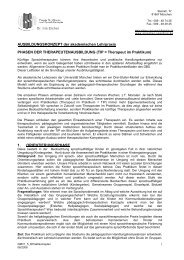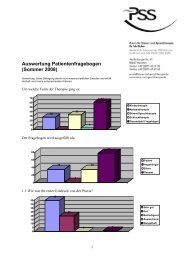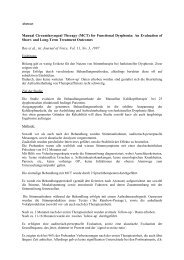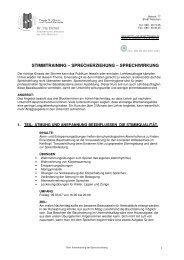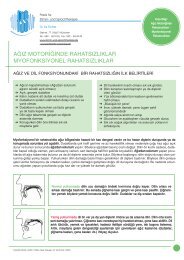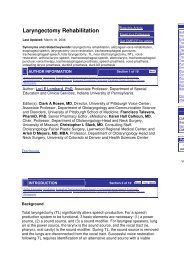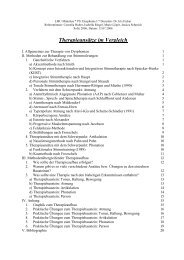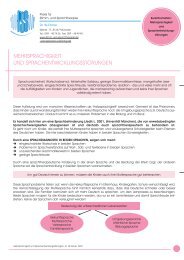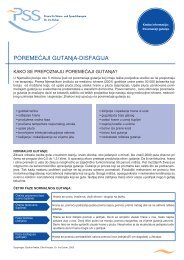Stroboscopy - Stimm-und-sprachtherapie.de
Stroboscopy - Stimm-und-sprachtherapie.de
Stroboscopy - Stimm-und-sprachtherapie.de
Create successful ePaper yourself
Turn your PDF publications into a flip-book with our unique Google optimized e-Paper software.
<strong>Stroboscopy</strong><br />
Last Updated: May 25, 2006<br />
Rate this Article<br />
Email to a<br />
Colleague<br />
Get CME/CE for<br />
article<br />
Synonyms and related keywords: stroboscopy, vi<strong>de</strong>ostrobe,<br />
vi<strong>de</strong>ostroboscopy, stroboscopy, vi<strong>de</strong>ostrobolaryngoscopy,<br />
strobolaryngoscopy, strobe, periodicity, amplitu<strong>de</strong>, glottic closure, mucosal<br />
wave, vocal fold cysts, vocal fold polyps, vocal fold nodules, sulcus vocalis,<br />
endoscopy, vocal fold anatomy, flexible endoscopy, rigid transoral<br />
endoscopy, glottic area waveform, GAW, phonatory cycle,<br />
vi<strong>de</strong>okymography, glottography, kymography, vi<strong>de</strong>ostrobokymography,<br />
stroboscope<br />
Author: Robert A Buckmire, MD, Associate Professor of<br />
Otolaryngology, Department of Otolaryngology, Head and<br />
Neck Surgery, University of North Carolina<br />
Robert A Buckmire, MD, is a member of the following medical<br />
societies: American Aca<strong>de</strong>my of Otolaryngology-Head and<br />
Neck Surgery, American College of Surgeons, and National<br />
Medical Association<br />
Editor(s): Clark A Rosen, MD, Director, University of<br />
Pittsburgh Voice Center; Associate Professor, Department of<br />
Otolaryngology and Communication Science and Disor<strong>de</strong>rs,<br />
University of Pittsburgh School of Medicine; Francisco<br />
Talavera, PharmD, PhD, Senior Pharmacy Editor, eMedicine;<br />
Erik Kass, MD, Chief, Department of Clinical Otolaryngology,<br />
Associates in Otolaryngology of Northern VA; Christopher L<br />
Slack, MD, Consulting Staff, Otolaryngology-Facial Plastic<br />
Surgery, Lawnwood Regional Medical Center; and Arlen D<br />
Meyers, MD, MBA, Professor, Department of Otolaryngology-<br />
Head and Neck Surgery, University of Colorado at Denver and<br />
Health Sciences Center<br />
Disclosure<br />
INTRODUCTION Section 2 of 8<br />
Author Information Introduction Backgro<strong>und</strong> And Surgical Principle Instrumentation Clinical<br />
Application Diagnostic Findings Exten<strong>de</strong>d Applications Bibliography<br />
In the mo<strong>de</strong>rn laryngological practice, vi<strong>de</strong>ostroboscopy is an<br />
essential diagnostic procedure for the <strong>de</strong>tection of vocal<br />
pathology.<br />
Many voice clinicians believe that successful voice surgery<br />
<strong>de</strong>pends as much on stroboscopy as otology <strong>de</strong>pends on<br />
audiometry or microscopy. Laryngologists recognize the
vibratory pattern of the vocal folds as one of the most crucial<br />
<strong>de</strong>terminants of voice quality and production. As such,<br />
vi<strong>de</strong>ostroboscopy is the most accessible and clinically relevant<br />
technique in the otolaryngologist's armamentarium to readily<br />
assess this important parameter. Results have important<br />
implications for both diagnosis and treatment of phonatory<br />
pathology.<br />
Over the past 3 <strong>de</strong>ca<strong>de</strong>s, knowledge of vocal fold anatomy and<br />
physiology has revolutionized the clinical practice of<br />
laryngology. Since Hirano's original <strong>de</strong>scription of the layered<br />
microanatomy of the human vocal fold in the 1970s,<br />
increasingly sophisticated diagnostic and surgical techniques<br />
have evolved to more appropriately address this <strong>de</strong>licate and<br />
complex structure now than then. Innovative diagnostic<br />
modalities have grown out of an improved <strong>und</strong>erstanding of the<br />
critical importance of vocal-fold oscillation to voice production.<br />
Vi<strong>de</strong>ostroboscopy has evolved as one of the most practical and<br />
useful techniques for the clinical evaluation of vocal-fold<br />
vibration.<br />
Vi<strong>de</strong>ostroboscopy fulfills several important requirements of a<br />
complete voice examination. It provi<strong>de</strong>s useful, real-time<br />
information concerning the nature of vibration, an image to<br />
<strong>de</strong>tect vocal pathology, and a permanent vi<strong>de</strong>o record of the<br />
examination. As important as any of these aspects,<br />
stroboscopy substantially improves the sensitivity of subtle<br />
laryngeal diagnoses over techniques, such as rigid or flexible<br />
transnasal laryngoscopy, with continuous light sources.<br />
BACKGROUND AND SURGICAL<br />
PRINCIPLE<br />
Section 3 of 8<br />
Author Information Introduction Backgro<strong>und</strong> And Surgical Principle Instrumentation Clinical<br />
Application Diagnostic Findings Exten<strong>de</strong>d Applications Bibliography<br />
The concept of stroboscopy is not new. For several centuries,<br />
stroboscopic images generated by using a flashing light source<br />
have been used to create the illusion of motion for<br />
entertainment. This practice is believed to date back to the<br />
ancient Greeks, who recreationally enjoyed these moving<br />
pictures. From the early 19th century, several examples<br />
illustrate the creation of moving-picture and optical toys, as well<br />
as scientific instruments. One <strong>de</strong>vice that used rotating disks to<br />
observe apparent motion, <strong>de</strong>veloped by a Viennese scientist<br />
named Stampfer, was called a stroboscope. This term is still<br />
used today to connote any pulsatile light-generating <strong>de</strong>vice<br />
<strong>de</strong>signed to observe motion.<br />
The history of using a stroboscopic light source to examine the<br />
larynx is nearly as long as that of the continuous light source,
dating back to the introduction of the laryngeal mirror by<br />
Manuel Garcia in 1855. In 1895, an internist named Oertel used<br />
a stroboscopic light source with a laryngeal mirror to investigate<br />
voice production in different registers. The application of the<br />
stroboscopic light source allowed the observer to view the<br />
vibrating vocal folds in arrested or apparent slow motion,<br />
permitting <strong>de</strong>tailed observations of the structure in the open or<br />
closed positions. Because of the limitations in illumination,<br />
precise control of the flashing frequency, poor image quality,<br />
and patient discomfort, members of the scientific community did<br />
not embrace this technique.<br />
In the early to mid 1900s, nearly 100 years after Plateau first<br />
suggested the use of an intermittent spark to illuminate moving<br />
objects to produce a stationary pattern for the purpose of study,<br />
H.E. Edgerton and associates <strong>de</strong>veloped gas discharge tubes<br />
for stroboscopy. They used an oscillator to control the<br />
frequency of the discharge and the flashing rate. Many of the<br />
principles of mo<strong>de</strong>rn stroboscopic <strong>de</strong>vices evolved from this<br />
early instrumentation.<br />
Pioneers of mo<strong>de</strong>rn strobolaryngoscopy inclu<strong>de</strong> Dr J.W. van<br />
<strong>de</strong>n Berg at the University of Groningen, Dr Rolf Timke at the<br />
University of Hamburg, Dr Hans von Le<strong>de</strong>n at the University of<br />
California, and Dr Elimar Schonharl in Erlanger, who wrote the<br />
first <strong>de</strong>finitive book on stroboscopic examination of the larynx in<br />
1960. With the subsequent improvements in audio- and vi<strong>de</strong>orecording<br />
technology and with the ongoing advancements in<br />
optical image resolution and fiberoptic light-source intensity, the<br />
mo<strong>de</strong>rn vi<strong>de</strong>ostroboscopic unit can now produce a crisp,<br />
brightly illuminated, magnified image.<br />
The Talbot law takes into account the physical reality that<br />
images on the human retina linger for 0.2 seconds after<br />
exposure (persistence of vision). Therefore, sequential images<br />
produced at intervals less than 0.2 seconds produce the illusion<br />
of a continuous image. This <strong>und</strong>erstanding, along with the<br />
concept of correspon<strong>de</strong>nce (interpretation of a corresponding<br />
portion of sequential images representing an object in motion),<br />
allows for the illusion of motion when rapidly produced still<br />
images are presented. Finally, a characteristic of the visual<br />
system permits interpretation of a series of slightly altered still<br />
images by filling in the gaps between frames and completing<br />
the illusion of continuous motion.<br />
Strobolaryngoscopy takes advantage of these principles by<br />
producing intermittent light flashes in close relation to the<br />
frequency of the vocal-fold vibration. A microphone picks up the<br />
frequency of the examinee's sustained voice, which triggers the<br />
stroboscopic light source. With the provision that the vocal<br />
vibrations are periodic, a frequency of light flashes equal to the
vocal frequency produces a clear, still image of the same<br />
portion to the vibratory cycle.<br />
When the frequency of the flashes is slightly less than the<br />
vibration of the vocal fold, it causes a <strong>de</strong>lay in the portion of<br />
each vibratory cycle illuminated, and the illusion of slow motion<br />
is obtained. However, in all healthy humans, vocal-fold<br />
vibrations are aperiodic to a greater or lesser <strong>de</strong>gree.<br />
Therefore, strobolaryngoscopy does not <strong>de</strong>monstrate fine <strong>de</strong>tail<br />
of each individual vibratory cycle; rather, it shows a pattern<br />
averaged over many successive noni<strong>de</strong>ntical cycles. In this<br />
sense, it is a less-than-perfect illustration of the true vibratory<br />
nature.<br />
INSTRUMENTATION<br />
Section 4 of 8<br />
Author Information Introduction Backgro<strong>und</strong> And Surgical Principle Instrumentation Clinical<br />
Application Diagnostic Findings Exten<strong>de</strong>d Applications Bibliography<br />
A vi<strong>de</strong>ostrobe unit consists of a stroboscopic unit (light source<br />
and microphone), a vi<strong>de</strong>o camera, an endoscope, and a vi<strong>de</strong>o<br />
recor<strong>de</strong>r. <strong>Stroboscopy</strong> can be performed by using either rigid or<br />
flexible endoscopes; each has its own benefits and drawbacks.<br />
Although flexible endoscopy is i<strong>de</strong>al for observing unaltered<br />
laryngeal behavior from various angles and for viewing the<br />
glottis through a narrow supraglottic aperture, it suffers from the<br />
low intensity of light carried through the long fiberoptic b<strong>und</strong>le<br />
to the tip of the narrow endoscope. With standard endoscopes,<br />
the light bouncing off objects being observed must then travel<br />
the length of the endoscope back to a camera or the operator's<br />
eye to be <strong>de</strong>tected.<br />
The introduction of distal-chip technology to flexible<br />
endoscopes, in which the camera is placed at the distal end of<br />
the scope, effectively lessened the drawback profile of flexible<br />
laryngoscopes. The enhanced digital picture quality with<br />
improved illumination has greatly improved the quality and<br />
resolution of transnasal laryngeal stroboscopy.<br />
Rigid transoral endoscopy produces a magnified bright image<br />
i<strong>de</strong>al for stroboscopy but requires holding of the patient's<br />
tongue throughout the examination, which distorts the natural<br />
phonatory posture of the pharynx and larynx. Moreover, the<br />
patient must have suitable anatomy and the physical tolerance<br />
to allow the clinician to visualize the entire glottis.<br />
Rigid endoscopy additionally requires increased patient<br />
cooperation and amenable patient anatomy for successful<br />
visualization of the larynx. Recent research has suggested that
the application of the Mallampati classification system is useful<br />
for predicting the a<strong>de</strong>quacy of transoral rigid laryngoscopic<br />
exposure for stroboscopy.<br />
CLINICAL APPLICATION Section 5 of 8<br />
Author Information Introduction Backgro<strong>und</strong> And Surgical Principle Instrumentation Clinical Application Diagnostic Findings<br />
Exten<strong>de</strong>d Applications Bibliography<br />
Several parameters may be evaluated during the course of the stroboscopic<br />
examination.<br />
• F<strong>und</strong>amental frequency: The f<strong>und</strong>amental frequency is measured by using the<br />
strobe unit and used to set the frequency of the light flashes. Strobe light is<br />
typically produced at a frequency several hertz slower than the vocal<br />
frequency to produce the illusion of a slow-motion vibratory cycle. An i<strong>de</strong>ntical<br />
frequency is emitted in the locked mo<strong>de</strong> that produces a still image of a single<br />
portion of the vibratory cycle.<br />
• Periodicity: Periodicity refers to the regularity of successive vocal motions.<br />
Normal vibratory activity is regular and periodic.<br />
• Amplitu<strong>de</strong>: Amplitu<strong>de</strong> refers to the lateral excursion of the vocal folds during<br />
their displacement away from the midline in oscillation. Typical amplitu<strong>de</strong> is<br />
approximately one third of the total width of the vocal fold. Amplitu<strong>de</strong> is<br />
generally gra<strong>de</strong>d as normal, less than normal, or greater than normal.<br />
• Symmetry: Normal motion of the vocal folds is symmetric, both in vibratory<br />
characteristic and in adductory and abductory motion.<br />
• Glottic closure: In the healthy person, the membranous portion of the vocal<br />
folds completely closes during the vibratory cycle. The posterior cartilaginous<br />
glottis may remain open (posterior glottic chink) in some healthy people.<br />
• Mucosal wave: The pattern of light traveling from mediolaterally along the<br />
superior surface of the vocal fold during vibration <strong>und</strong>er illumination is referred<br />
to as the mucosal wave. It is a correlate of the pliable cover (epithelium and<br />
superficial lamina propria) of the vocal fold being displaced relative to the body<br />
of the vocal fold (vocalis muscle). Focal abnormalities of mucosal wave help to<br />
localize pathology in the vocal fold.<br />
DIAGNOSTIC FINDINGS Section 6 of 8<br />
Author Information Introduction Backgro<strong>und</strong> And Surgical Principle Instrumentation Clinical Application Diagnostic Findings<br />
Exten<strong>de</strong>d Applications Bibliography<br />
By increasing the illumination and evaluation of vibratory patterns, vi<strong>de</strong>ostroboscopy<br />
has vastly increased the sensitivity of laryngologic diagnoses. Despite the variations<br />
attributable to lesion size, concurrent vocal pathologies, and compensatory<br />
phonatory behaviors, generalizations can be ma<strong>de</strong> about stroboscopic findings<br />
accompanying specific true vocal-fold pathology. The most common benign laryngeal<br />
lesions and their typical stroboscopic findings are <strong>de</strong>scribed below.<br />
Vocal-fold cysts
Vocal-fold cysts are encapsulated, benign lesions located in the superficial lamina<br />
propria of the vocal fold. They are generally unilateral, though several may be<br />
present at the time of diagnosis. On stroboscopy, the vocal fold generally has a<br />
ro<strong>und</strong>ed, full appearance on the affected si<strong>de</strong>. Gaps anterior and posterior to the<br />
lesion may compromise glottic closure, <strong>de</strong>pending on their size. The vibratory<br />
patterns of the 2 vocal folds are asymmetrical, with diminution of amplitu<strong>de</strong> on the<br />
affected si<strong>de</strong>.<br />
A substantially <strong>de</strong>creased mucosal wave is present throughout the affected si<strong>de</strong> and<br />
absent over the cyst itself, an important finding for differentiating a cyst from a nodule<br />
or polyp (which may have similar appearances on continuous-light examination). An<br />
altered vibratory pattern is often the only physical finding in the presence of a small<br />
cyst that does not alter the contour of the vocal fold.<br />
Vocal-fold polyps<br />
Vocal-fold polyps may be unilateral or bilateral. These lesions represent pathology in<br />
the superficial lamina propria. They may be of any consistency, ranging from<br />
gelatinous to hyalinized. Glottic closure may be compromised, leaving gaps anterior<br />
and posterior to the lesion in maximal closure. The vibratory patterns of the 2 vocal<br />
folds are asymmetrical, with diminution of vibration near the lesion. Mucosal wave<br />
may be present over the polyp itself, <strong>de</strong>pending on its physical consistency.<br />
Vocal-fold nodules<br />
Vocal-fold nodules are bilateral lesions that are roughly symmetrical. The relevant<br />
pathology occurs at the basement membrane zone between the overlying epithelium<br />
and the <strong>und</strong>erlying lamina propria. The vocal folds have the appearance of medial<br />
fullness, typically at the junction of the anterior and middle third of the fold. Glottic<br />
closure is compromised. Mucosal wave is present bilaterally, though both it and the<br />
vibratory amplitu<strong>de</strong> may be <strong>de</strong>creased.<br />
Sulcus vocalis<br />
Sulcus vocalis is a focal furrow in the covering of the vocal fold. These lesions most<br />
often are unilateral and represent a tethering of the overlying epithelium to the<br />
<strong>de</strong>eper connective tissue. Glottic closure is incomplete. <strong>Stroboscopy</strong> <strong>de</strong>monstrates a<br />
focal interruption in the mucosal wave at the site of the sulcus, and vibratory patterns<br />
are asymmetrical between the true vocal folds.<br />
EXTENDED APPLICATIONS Section 7 of 8<br />
Author Information Introduction Backgro<strong>und</strong> And Surgical Principle Instrumentation Clinical Application Diagnostic Findings<br />
Exten<strong>de</strong>d Applications Bibliography<br />
Although vi<strong>de</strong>ostroboscopy greatly expands the diagnostic sensitivity of<br />
laryngoscopy, its interpretation <strong>de</strong>pends on the skill and experience of the clinician<br />
performing the study, and specifically, the skill and experience of the diagnostic<br />
interpreter. The quality of the images collected is directly related to the skill of the<br />
operator performing the procedure. In addition, recent research suggests that even,<br />
among the most experienced interpreters, interrater correlations for judging specific
parameters is mo<strong>de</strong>rate (kappa = 0.61-0.81) at best. Although increased experience<br />
in reviewing stroboscopic results appeared to have a mo<strong>de</strong>st positive effect on a<br />
clinician's intrarater reliability, it did not necessarily improve interrater correlation i a<br />
group of similarly experienced examiners.<br />
Several technologies have been <strong>de</strong>veloped to improve objective measurements of<br />
the amplitu<strong>de</strong> of vibration and mucosal wave. Software was <strong>de</strong>veloped to measure<br />
the glottic-area waveform (GAW), a plot of the glottic area against the time of opening<br />
and closing of the glottis during a representative vibratory cycle (taken from of the<br />
stroboscopic image). From this information, glottal opening and closing rates are<br />
calculated. These measurements are purported to be correlates of vocal-fold pliability<br />
and statistically differ in preoperative and postoperative states for benign vocal-fold<br />
lesions.<br />
An admitted limitation of the stroboscopic image is that vocal-fold vibration must be<br />
relatively periodic to visualize a slow-motion representation of the phonatory cycle.<br />
Efforts to extend the sensitivity of laryngoscopy, to incorporate variations of wave<br />
characteristic across the glottis and in aperiodic patterns of vibration have yiel<strong>de</strong>d<br />
new techniques.<br />
Vi<strong>de</strong>okymography is a recent technique based on the principles of high-speed<br />
glottography. This method allows for the isolation of specific portions on the glottic<br />
image (obtained at rates of up to 7812 images per second), which are analyzed for<br />
closure. The suggested advantage over stroboscopy alone is the ability to evaluate 1<br />
portion of the glottis in comparison to another while avoiding the limitation of vibratory<br />
periodicity. This technique also allows for accurate objective measurements of the<br />
glottal gap without the inherent error produced by stroboscopic averaging of many<br />
individual glottic cycles.<br />
An additional effort to extend the diagnostic range by combining the<br />
vi<strong>de</strong>ostroboscopic image with kymography (line drawings representing the distance<br />
between <strong>de</strong>fined points on successive images), resulted in the creation of<br />
vi<strong>de</strong>ostrobokymography. This technique uses the standard image generated during<br />
vi<strong>de</strong>ostrobolaryngoscopy and digitalizes individual frames. Kymograms of multiple<br />
segments along the glottis are then produced. This marriage of the stroboscopic<br />
image and the objective measure of vocal-fold vibration as it varies across the<br />
surface of the glottis is a potentially powerful tool, without the need for additional<br />
camera technology, as is required for vi<strong>de</strong>okymography. On the contrary, this newer<br />
technique is subject to all of the technical limitations of the original stroboscopic<br />
imaging process.<br />
BIBLIOGRAPHY Section 8 of 8<br />
Author Information Introduction Backgro<strong>und</strong> And Surgical Principle Instrumentation Clinical Application Diagnostic Findings<br />
Exten<strong>de</strong>d Applications Bibliography<br />
• Ferlito A: Diseases of the larynx. New York: Oxford University Press; 2000.<br />
• Hirano M, Bless DM: Vi<strong>de</strong>ostroboscopic examination of the larynx. San Diego:<br />
Singular; 1993.<br />
• Hirano M: Morphological structure of the vocal cord as a vibrator and its<br />
variations. Folia Phoniatr (Basel) 1974; 26(2): 89-94[Medline].
• Low C, Young P, Webb CJ, et al: A simple and reliable predictor for an<br />
a<strong>de</strong>quate laryngeal view with rigid endoscopic laryngoscopy. Otolaryngol<br />
Head Neck Surg 2005 Feb; 132(2): 244-6[Medline].<br />
• Metson R, Rauch SD: Vi<strong>de</strong>olaryngoscopy in the office--a critical evaluation.<br />
Otolaryngol Head Neck Surg 1992 Jan; 106(1): 56-9[Medline].<br />
• Noordzij JP, Woo P: Glottal area waveform analysis of benign vocal fold<br />
lesions before and after surgery. Ann Otol Rhinol Laryngol 2000 May; 109(5):<br />
441-6[Medline].<br />
• Rosen CA, Murry T: Nomenclature of voice disor<strong>de</strong>rs and vocal pathology.<br />
Otolaryngol Clin North Am 2000 Oct; 33(5): 1035-46[Medline].<br />
• Rosen CA: <strong>Stroboscopy</strong> as a research instrument: <strong>de</strong>velopment of a<br />
perceptual evaluation tool. Laryngoscope 2005 Mar; 115(3): 423-8[Medline].<br />
• Schutte HK, Svec JG, Sram F: First results of clinical application of<br />
vi<strong>de</strong>okymography. Laryngoscope 1998 Aug; 108(8 Pt 1): 1206-10[Medline].<br />
• Shohet JA, Courey MS, Scott MA, Ossoff RH: Value of vi<strong>de</strong>ostroboscopic<br />
parameters in differentiating true vocal fold cysts from polyps. Laryngoscope<br />
1996 Jan; 106(1 Pt 1): 19-26[Medline].<br />
• Sung MW, Kim KH, Koh TY, et al: Vi<strong>de</strong>ostrobokymography: a new method for<br />
the quantitative analysis of vocal fold vibration. Laryngoscope 1999 Nov;<br />
109(11): 1859-63[Medline].<br />
• Yanagisawa E, Owens TW, Strothers G, Honda K: Vi<strong>de</strong>olaryngoscopy. A<br />
comparison of fiberscopic and telescopic documentation. Ann Otol Rhinol<br />
Laryngol 1983 Sep-Oct; 92(5 Pt 1): 430-6[Medline].



